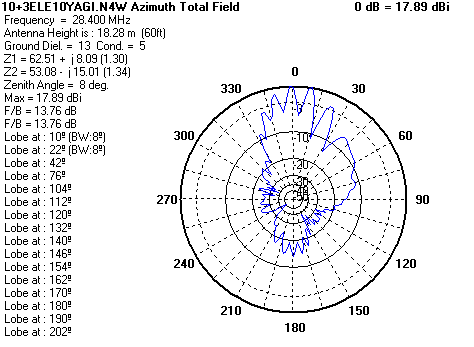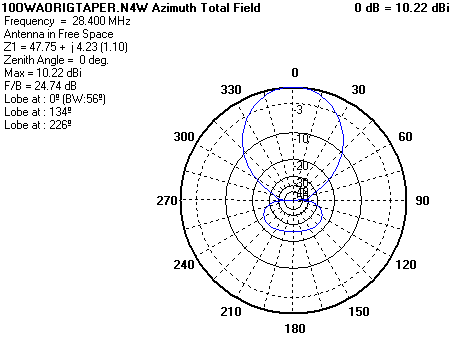
As I mentioned in Part 2, I have had great luck with beaming in two directions at the same time. I also am very aware of concerns that theoretical stacking gain can't actually be realized in real installations, especially on hill-tops. So I came up with the idea of using fixed yagi's aimed at EU and JA, in addition to the rotating yagi's on the tower. Tom has a bunch of handy trees about 65' tall that would be perfect for hanging wire beams. The trees are about 300 feet away from the tower. I could use a StackMatch to power split between the yagi's on the tower, and the dedicated wire beams. This was sort of the"'if some is good, more must be better" type of thinking. "I'll just put up 3 big yagi's on the tower, and then build a couple of huge wire beams too. How hard can it be?" (hi hi). Seems almost funny in retrospect. Remember, this was somewhere around the 10th of October. At this point, I was still thinking that the contest was months away, and that I had plenty of time to get ready.
So off I went. I spent a couple of hours reading about high gain
antenna design. I thought about a rhombic,
and read all about N5APR
and W6AM's stations. I gave up on rhombics after realizing that they
take real work to build :-) Besides, I know (more or less) how to
build yagi's, and with the trees about 200 feet apart, I had room for a
real 'long boom yagi'! I got excited about DL6WU's work, and modeled
a 10 element direct 50 ohm feed DL6WU design on a 80 foot boom. I
created the design by scaling up a yagi designed for 432 Mhz to 28.4 Mhz.
If you are interested, here is the model:
|
|
|
|
|
|
|
|
|
|
|
|
|
|
|
|
|
|
|
|
|
|
|
|
|
|
|
|
|
|
|
|
|
|
|
|
|
|
|
|
|
|
|
|
Gain is above 13.7 dbi over the interesting part of 10 meters, and the antenna is under 2:1 SWR for 700 Khz or so. A very decent design, given that I put less than an hour into tweaking it. I was psyched. The very thought of an antenna dedicated to Europe with almost 14 dbi of gain was enough to get the adrenaline flowing!
But I am a logical guy, so my next step was to model this antenna fed in phase with one or more antennas on the tower, to simulate the actual contest scenario of beaming to EU with the DL6WU and stateside with the tower. When I ran the model (this and all my other computer antenna modeling is done on NEC4WIN95), this is what I got for an azimuth pattern (0 degrees would be towards Europe with the 10 ele., and 45 degrees towards US with a place holder 3 ele.):

Yikes! I had expected the nice smooth ovals that I see when I model two antennas on a tower facing different directions. Instead, I got something that looked like my daughter's milk on the floor after a tantrum. A few minutes of thinking and modeling plus a quick email to antenna guru L.B. Cebik, confirmed that the two signals were interacting much the same way that the light from two flashlights would - adding and subtracting in very odd ways. The result, as you can see, is a pattern with deep fingers in the gain profile. Nothing I did in terms of changing the feed phase, or moving the antennas further apart or closer together made it better. I wasn't at all comfortable with this pattern - stations in Paris might be 10 db down from stations in Berlin. In retrospect, I wonder if the guys with lots of towers have ever modeled their installations - this plot certainly made me nervous. If I was going to do all the work of putting up two of these monsters, I wanted predictable results. So I abandoned this line of thinking, and went back to working on the stack on the tower.
That left me with the question of what type of yagi to build.
For a long time, I have been enamored with the OWA yagi design by NW3Z, Nathan Miller. I do not consider myself an antenna expert, and the idea of dealing with 'complicated' matching schemes has always bothered me. The fact that the OWA design is a direct 50 ohm feed with excellent bandwidth is a big attraction. Add to that the nice smooth gain curve and fairly broad beam width, and the 24' 6 element 10 meter OWA design looks mighty good.
A brief side note on antenna design by K6IF. From the West Coast, I believe that front-to-back is basically useless. Yes, it can improve the signal-to-noise ratio, which is great. But for contests, you almost always want to be able to hear to your rear. When you are beaming Japan, the back of the antenna is aimed at South America (where the band is probably also open). So I always aim for maximum gain, and pretty much ignore F/B. Also, a broad front lobe is very important. For stateside contests from San Francisco, if you want to cover Minnesota to Texas, you need about 60 degrees of beam width. To cover Norway to Spain, you also need about 60 degrees of beam width. So I strongly prefer designs that have wide front lobes. Here the 24' boom OWA really shines, with a 3 db down beam width of almost exactly 60 degrees.

So I was all set to plan on using the OWA design, and I was going to order all the tubing from Texas Towers and build them myself. I posted a note to Tower Talk asking about boom materials, and KI7WX wrote me back and basically said 'why build OWA's when Hy-Gain 105CA's have better overall performance and are available new for <$250?" That really got me thinking. I read everything I could about the 105CA, and looked at both Hy-Gain's computer models and N6BV's optimized version. I realized that 105CA's were hard to come by since MFJ bought Hy-Gain, so I bought the last 105CA that Burghardt had in stock. I figured that no matter what I decided to do, the 105CA would be a good source of parts at a fair price.
So now how to proceed? I had a brand new 105CA. One of the antennas that we removed from Tom's tower was a slightly damaged KLM 10 meter Big Sticker - 6 elements on a 27' boom. Tom and I rooted around in his garage, and found the remains of a 15 meter Big Sticker, enough 2" boom stock and element parts to build most of a third antenna. I had an old Gotham 4 element 10 meter monobander in my garage, and its elements were intact. So I had plenty of aluminum, I just needed a plan.
At first, I thought that I would go with 105CA's. I advertised on QTH.com and EHAM.net trying to buy two more used ones, but struck out. I opened up the one I bought, and studied the design. The more I thought about it, the less I liked the idea of trying to build 2 Hy-Gain clones from my parts. As you may know, the 105CA uses a beta matching scheme, and has a native feed impedance of around 25 ohms. The antenna has fairly narrow bandwidth (even on the 'wide band' setting), and the impedance changes a fair bit over the band. When you are stacking antennas with a StackMatch, you want them to be as identical as possible. In particular, as I understand it, the amount of power delivered to each antenna depends on its impedance relative to the other antennas in the stack. So to get equal power to each antenna, they have to have equal impendances.
My concern was that I would not be able to build 3 antennas with sufficiently similar impedance curves, and that would effect their stacked performance. There were really two issues. First, the Hy-Gain uses a unique, through the boom, element mounting system. There was no way that I could replicate their clam-shell element mounting plates, so the two clones would have to use some other element mounting system. I had no confidence that I could model the boom to element interactions on a computer well enough to get the designs exactly the same electrically. That led to the second issue - the fact that the 105CA is fairly narrow banded. If I didn't get the antennas electrically identical, the impedance differences might be pretty large, even with a small error. On the other hand, the OWA design is very broad banded. Even if I screwed up the modeling or construction slightly, the impact would be small.
In the end, I decided that I was better off building 3 OWA antennas, each identical except for their element taper schedule. I knew that I could model the taper on the computer much more accurately than I could model the boom effects. So now I had a plan. The question was, could I turn my plan into reality?
Part 4: The rubber hits the road